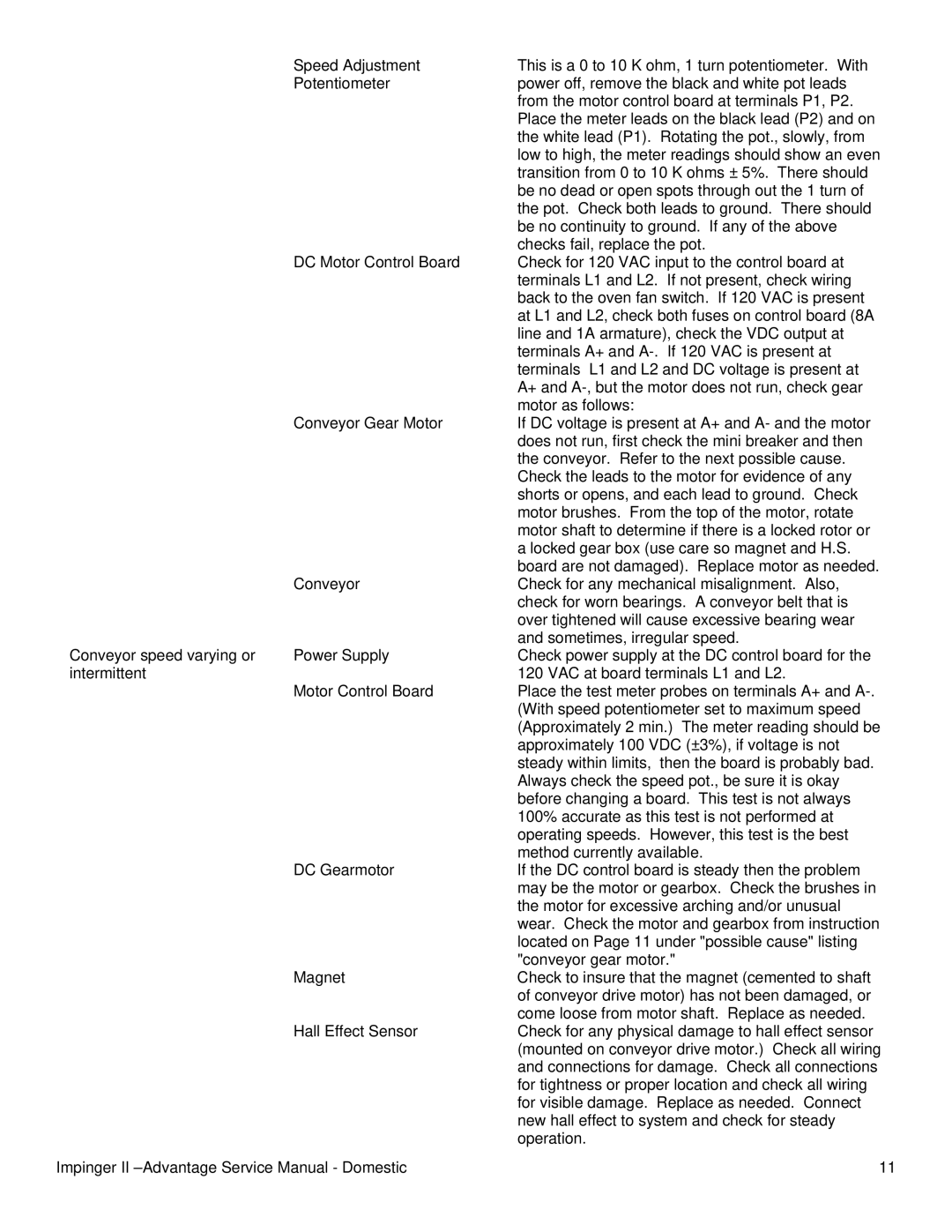| Speed Adjustment | This is a 0 to 10 K ohm, 1 turn potentiometer. With |
| Potentiometer | power off, remove the black and white pot leads |
|
| from the motor control board at terminals P1, P2. |
|
| Place the meter leads on the black lead (P2) and on |
|
| the white lead (P1). Rotating the pot., slowly, from |
|
| low to high, the meter readings should show an even |
|
| transition from 0 to 10 K ohms ± 5%. There should |
|
| be no dead or open spots through out the 1 turn of |
|
| the pot. Check both leads to ground. There should |
|
| be no continuity to ground. If any of the above |
|
| checks fail, replace the pot. |
| DC Motor Control Board | Check for 120 VAC input to the control board at |
|
| terminals L1 and L2. If not present, check wiring |
|
| back to the oven fan switch. If 120 VAC is present |
|
| at L1 and L2, check both fuses on control board (8A |
|
| line and 1A armature), check the VDC output at |
|
| terminals A+ and |
|
| terminals L1 and L2 and DC voltage is present at |
|
| A+ and |
|
| motor as follows: |
| Conveyor Gear Motor | If DC voltage is present at A+ and A- and the motor |
|
| does not run, first check the mini breaker and then |
|
| the conveyor. Refer to the next possible cause. |
|
| Check the leads to the motor for evidence of any |
|
| shorts or opens, and each lead to ground. Check |
|
| motor brushes. From the top of the motor, rotate |
|
| motor shaft to determine if there is a locked rotor or |
|
| a locked gear box (use care so magnet and H.S. |
|
| board are not damaged). Replace motor as needed. |
| Conveyor | Check for any mechanical misalignment. Also, |
|
| check for worn bearings. A conveyor belt that is |
|
| over tightened will cause excessive bearing wear |
|
| and sometimes, irregular speed. |
Conveyor speed varying or | Power Supply | Check power supply at the DC control board for the |
intermittent |
| 120 VAC at board terminals L1 and L2. |
| Motor Control Board | Place the test meter probes on terminals A+ and |
|
| (With speed potentiometer set to maximum speed |
|
| (Approximately 2 min.) The meter reading should be |
|
| approximately 100 VDC (±3%), if voltage is not |
|
| steady within limits, then the board is probably bad. |
|
| Always check the speed pot., be sure it is okay |
|
| before changing a board. This test is not always |
|
| 100% accurate as this test is not performed at |
|
| operating speeds. However, this test is the best |
|
| method currently available. |
| DC Gearmotor | If the DC control board is steady then the problem |
|
| may be the motor or gearbox. Check the brushes in |
|
| the motor for excessive arching and/or unusual |
|
| wear. Check the motor and gearbox from instruction |
|
| located on Page 11 under "possible cause" listing |
|
| "conveyor gear motor." |
| Magnet | Check to insure that the magnet (cemented to shaft |
|
| of conveyor drive motor) has not been damaged, or |
|
| come loose from motor shaft. Replace as needed. |
| Hall Effect Sensor | Check for any physical damage to hall effect sensor |
|
| (mounted on conveyor drive motor.) Check all wiring |
|
| and connections for damage. Check all connections |
|
| for tightness or proper location and check all wiring |
|
| for visible damage. Replace as needed. Connect |
|
| new hall effect to system and check for steady |
|
| operation. |
Impinger II | 11 | |
Page 11
Image 11
